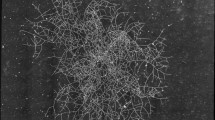Abstract
WhenErwinia amylovora grows, in an intercellular space of a host, and fills this space, further multiplication or swelling may create a pressure, and may cause tearing of host tissue. Theoretically, this bacterial pressure equals the actual water potential of the host tissue minus the water potential at which the bacterial biomass would completely fill the intercellular space, but without exerting pressure.
Simulation runs indicate that, when the pressure increases, the extracellular slime ofE. amylovora shrinks by releasing water, thus allowing further production of bacterial dry matter. The slime remains around the bacterial cells as a dense substance, low in water content, having a strong capacity to swell when the pressure induces tearing apart of the host tissue. Simulation runs show that the pressure attains its highest values at evening and night.
Some fire blight symptoms that illustrate the evidence of bacterial pressure are discussed.
Similar content being viewed by others
References
Ayers, A.R., Ayers, S.B. & Goodman, R.N., 1979. Extracellular polysaccharide ofErwinia amylovora: a correlation with virulence. Applied and Environmental Microbiology 38: 659–666.
Billing, E., 1974. The effect of temperature on the growth of the fireblight pathogen,Erwinia amylovora. Journal of Applied Bacteriology 37:643–648.
Eden-Green, S.J., 1972. Studies in fireblight disease of apple, pear and hawthorn. Ph.D. dissertation, University of London, 202 pp.
Eden-Green, S.J. & Billing, E., 1972. Fireblight: Occurrence of bacterial strands on various hosts under glasshouse condition. Plant Pathology 21: 121–123.
Eden-Green, S.J. & Knee, M., 1974. Bacterial polysaccharide and sorbitol in fireblight exudate. Journal of General Microbiology 81: 509–512.
Fischer, E.G., Parker, K.G., Luepschen, N.S. & Kwong, S.S., 1959. The influence of phosphorus, potassium, mulch, and soil drainage on fruit size, yield and firmness of the Bartlett pear and on development of the fire blight disease. Proceedings of the American Society for Horticultural, Science 73: 78–90.
Hockenhull, J., 1974. Some anatomical and pathological features of healthy and diseased hawthorn (Crataegus monogyna) naturally infected by the fireblight pathogenErwinia amylovora. The Royal Veterinary and Agricultural University, Yearbook 1974: 125–136.
Huang, P., 1974. Ultrastructural modification by and pathogenicity ofErwinia amylovora in apple tissues. Ph.D. dissertation, University of Missouri-Columbia, 135 pp.
Huang, P. & Goodman, R.N., 1976. Ultrastructural modifications in apple stems induced byErwinia amylovora and the fire blight toxin. Phytopathology 66: 269–276.
Keil, H.L. & Van der Zwet, T., 1972. Aerial strands ofErwinia amylovora: Structure and enhanced production by pesticide oil. Phytopathology 62: 355–361.
Parker, K.G., Luepschen, N.S., & Fischer, E.G., 1961. Tree nutrition and fire blight development. Phytopathology 51: 557–560.
Powell, D.B.B. & Thorpe, M.R., 1977. Dynamic aspects of plant- water relations. In: Landsberg, J.J. & Cutting, C.V. (Eds), Environmental effects on crop physiology. London: Academic Press. p. 259–279.
Schouten, H.J., 1987a. Confidence intervals for the estimation of the incubation period of fire blight following Billing's prediction system 1. Netherlands Journal of Plant Pathology 94: 49–53.
Schouten, H.J., 1987b. A revision of Billing's potential doublings table for fire blight prediction. Netherlands Journal of Plant Pathology 93: 55–60.
Schouten, H.J., 1988. Notes on the role of water potential in the pathogenesis of fire blight, caused byErwinia amylovora. Netherlands Journal of Plant Pathology 94: 213–220.
Schouten, H.J., 1989. A possible role for the swelling of extracellular slime ofErwinia amylovora at increasing water potential. Netherlands Journal of Plant Pathology 95, Supplement 1: 169–174.
Shaw, L., 1935. Intercellular humidity in relation to fire-blight susceptibility in apple and pear. Cornell University Agricultural Experiment Station, Ithaca New York. nr. 181, 40 pp.
Van der Zwet, T. & Keil, H.L., 1979. Fire blight. A bacterial disease of rosaceous plants. Agriculture handbook nr. 510. Washington: United States Department of Agriculture, 200 pp.
Wilson, M., Epton, H.A.S., & Sigee, D.C., 1987. Ultrastructural studies on fire blight of hawthorn flowers. Acta Horticulturae 217:189–194.
Author information
Authors and Affiliations
Rights and permissions
About this article
Cite this article
Schouten, H.J. Simulation of pressure caused by multiplication and swelling of Erwinia amylovora in intercellular space of host tissue. Netherlands Journal of Plant Pathology 97, 139–149 (1991). https://doi.org/10.1007/BF01995962
Accepted:
Issue Date:
DOI: https://doi.org/10.1007/BF01995962




